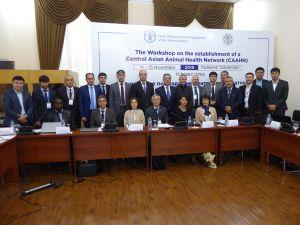Establishment of a Central Asian Animal Health Network (CAAHN)
Hybrid Event, 14/11/2019 - 15/11/2019

Participating countries:
Tajikistan, Uzbekistan, Kazakhstan, Kyrgyzstan and Turkmenistan
The International regulations in Animal health present a challenge and opportunity for global surveillance and control of infectious diseases. Livestock diseases adversely impact the productivity of livestock production systems by reducing the quantity and quality of livestock-derived products. Doing so, they do not only challenge the livelihoods of the producers, but can have major socio-economic consequences for the wider population. Additionally, the trade restrictions that often accompany the reporting of livestock diseases, may add a considerable economic burden, particularly to exporting countries. Control measures, such as massive depopulations, will also add to the cost, both from the economic and the social points of view.
Establishment of regional networks is an opportunity to address these challenges.
Animal health networks offer a framework for building strong technical capacity, competency, leadership and a critical mass of regionally networked specialists in veterinary medicine, epidemiology, surveillance and diagnosis – all of which are essential to coordinate actions to manage the risks of transboundary animal diseases and zoonoses.
Experience from regional animal health networks in other regions has already proven successful. FAO has lead with other international agencies the establishment and support of several regional animal health networking initiatives in various regions of the world, e.g. RESEPI and RESOLAB in Western and Central Africa, EARLN and EAREN in East Africa, REMESA in Northern Africa, and also in Southeast and South Asia. The examples above are a valuable tool to build synergies and efficiency in terms of animal health expertise and to enhance transparency and mutual confidence in disease information exchange.
Regional animal health networks offer a framework for building strong technical capacity, competency, leadership and a critical mass of regionally networked specialists. A Central Asian Animal Health Network (CAAHN could become successful by means of enhanced cooperation between veterinary services, exchange of people, training and capacity building, organization of ring trials, joint work plans, etc.
The initial driver of the network will be brucellosis, which is a high priority for all Central Asian countries. Bovine and small ruminant brucellosis can be controlled and, as the primary responsibility of all governments is to protect all people leaving no one behind, it is their duty to give high priority to reducing risks associated with zoonotic diseases. FAO and the U.S. Centers for Disease Control and Prevention have jointly developed a Stepwise Approach for the Progressive Control of Brucellosis (SPCB) to aid countries along the progressive control process.
Organizers: FAO, through its regional office for Europe and Central Asia (REU), will function as the initial driver of this animal health network, which will serve as an umbrella under which laboratory and the epidemiology networks operate. Coordination with the World Organisation for Animal Health (OIE) will be promoted.
Language: English with simultaneous translation to Russian
Objectives:
- harmonize policies and approaches
- identify gaps, weaknesses and priorities/fulfil gaps by providing training, capacity building
- exchange information and experience
- standardize laboratory, field prevention/control, operating, communication and other procedures
- efficient coordination of disease/theme specific sub-network
Participants:
- FAO-sponsored*: Tajikistan, Uzbekistan, Kazakhstan, Kyrgyzstan and Turkmenistan
- Representatives from FAO, World Organisation for Animal Health (OIE), European Commission for the Control of Foot-and-Mouth Disease (EuFMD)
Three participants per country (CVO, one epidemiologists, and one laboratory expert)
During day 1, t is expected to provide countries with examples of other successfully operating regional networks, conduct technical presentations with discussion sessions setting the baseline for establishing a CAAHN applying FAO tools, and developing by countries a detailed Action plan.
Day 2 will focus on a jointly developed Action plan, application of tools on information sharing and formulation of recommendations.
